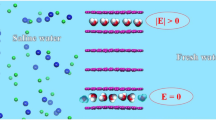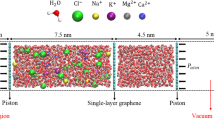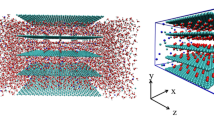Abstract
Using molecular dynamics (MD) simulations, a porous graphene membrane was exposed to external electric fields to separate positive and negative ions from salt-water and to produce fresh water. It was observed that, by increasing the strength of the applied electric field, ion separation improved noticeably. In addition, to obtain fresh water, the designed system included two graphene membranes, which are exposed to two external electric fields in opposite directions. Ion rejection was found to be greater than 93% for the electric field of 10 mV/Å and higher. This atomic-level simulation increases the understanding of electric field effects on desalination using multilayer graphene membranes and can be helpful in designing more efficient membranes.

Similar content being viewed by others
References
Hu, Z. Q.; Chen, Y. F.; Jiang, J. W. Zeolitic imidazolate framework-8 as a reverse osmosis membrane for water desalination: Insight from molecular simulation. J. Chem. Phys. 2011, 134, 134705.
Gupta, K. M.; Zhang, K.; Jiang, J. W. Water desalination through zeolitic imidazolate framework membranes: Significant role of functional groups. Langmuir 2015, 31, 13230–13237.
Katekomol, P.; Roeser, J.; Bojdys, M.; Weber, J.; Thomas, A. Covalent triazine frameworks prepared from 1,3,5- tricyanobenzene. Chem. Mater. 2013, 25, 1542–1548.
Lin, L. C.; Cho, J.; Grossman, J. C. Two-dimensional covalent triazine framework as an ultrathin-film nanoporous membrane for desalination. Chem. Commun. 2015, 51, 14921–14924.
Zhao, K. W.; Wu, H. Y. Fast water thermo-pumping flow across nanotube membranes for desalination. Nano Lett. 2015, 15, 3664–3668.
Das, R.; Ali, M. E.; Hamid, S. B. A.; Ramakrishna, S.; Chowdhury, Z. Z. Carbon nanotube membranes for water purification: A bright future in water desalination. Desalination 2014, 336, 97–109.
Majumder, M.; Chopra, N.; Andrews, R.; Hinds, B. J. Nanoscale hydrodynamics: Enhanced flow in carbon nanotubes. Nature 2005, 438, 44.
Kar, S.; Bindal, R. C.; Tewari, P. K. Carbon nanotube membranes for desalination and water purification: Challenges and opportunities. Nanotoday 2012, 7, 385–389.
Fornasiero, F.; In, J. B.; Kim, S.; Park, H. G.; Wang, Y. M.; Grigoropoulos, C. P.; Noy, A.; Bakajin, O. pH-tunable ion selectivity in carbon nanotube pores. Langmuir 2010, 26, 14848–14853.
Oyama, S. T.; Stagg-Williams, S. M. Inorganic, Polymeric and Composite Membranes; Elsevier: Amsterdam, The Netherlands, 2011.
Cohen-Tanugi, D.; Grossman, J. C. Water desalination across nanoporous graphene. Nano Lett. 2012, 12, 3602–3608.
Nair, R. R.; Wu, H. A.; Jayaram, P. N.; Grigorieva, I. V.; Geim, A. K. Unimpeded permeation of water through heliumleak-tight graphene-based membranes. Science 2012, 335, 442–444.
Surwade, S. P.; Smirnov, S. N.; Vlassiouk, I. V.; Unocic, R. R.; Veith, G. M.; Dai, S.; Mahurin, S. M. Water desalination using nanoporous single-layer graphene. Nat. Nanotechnol. 2015, 10, 459–464.
Song, B.; Zhang, C.; Zeng, G. M.; Gong, J. L.; Chang, Y. N.; Jiang, Y. Antibacterial properties and mechanism of graphene oxide-silver nanocomposites as bactericidal agents for water disinfection. Archiv. Biochem. Biophys. 2016, 604, 167–176.
Lattemann, S.; Hoepner, T. Environmental impact and impact assessment of seawater desalination. Desalination 2008, 220, 1–15.
Song, B.; Zeng, G. M.; Gong, J. L.; Liang, J.; Xu, P.; Liu, Z. F.; Zhang, Y.; Zhang, C.; Cheng, M.; Liu, Y. et al. Evaluation methods for assessing effectiveness of in situ remediation of soil and sediment contaminated with organic pollutants and heavy metals. Environ. Int. 2017, 105, 43–55.
Ritos, K.; Borg, M. K.; Mottram, N. J.; Reese, J. M. Electric fields can control the transport of water in carbon nanotubes. Phil. Trans. R. Soc. A: Math. Phys. Eng. Sci. 2016, 374, 20150025.
Su, J. Y.; Guo, H. X. Control of unidirectional transport of single-file water molecules through carbon nanotubes in an electric field. ACS Nano 2011, 5, 351–359.
Ghadamgahi, M.; Ajloo, D. Molecular dynamics simulation of the water transportation through a carbon nanotube. The effect of electric field. Russ. J. Phys. Chem. A 2015, 89, 2120–2125.
Rinne, K. F.; Gekle, S.; Bonthuis, D. J.; Netz, R. R. Nanoscale pumping of water by AC electric fields. Nano Lett. 2012, 12, 1780–1783.
Meng, X. W.; Wang, Y.; Zhao, Y. J.; Huang, J. P. Gating of a water nanochannel driven by dipolar molecules. J Phys. Chem. B 2011, 115, 4768–4773.
Li, X. P.; Kong, G. P.; Zhang, X.; He, G. W. Pumping of water through carbon nanotubes by rotating electric field and rotating magnetic field. Appl. Phys. Lett. 2013, 103, 143117.
Rikhtehgaran, S.; Lohrasebi, A. Water desalination by a designed nanofilter of graphene-charged carbon nanotube: A molecular dynamics study. Desalination 2015, 365, 176–181.
Figueras, L.; Faraudo, J. Competition between hydrogen bonding and electric field in single-file transport of water in carbon nanotubes. Mol. Simul. 2012, 38, 23–25.
Zhu, J. Z.; Lan, Y. Q.; Du, H. J.; Zhang, Y. H.; Su, J. G. Tuning water transport through nanochannels by changing the direction of an external electric field. Phys. Chem. Chem. Phys. 2016, 18, 17991–17996.
Winarto; Takaiwa, D.; Yamamoto, E.; Yasuoka, K. Structures of water molecules in carbon nanotubes under electric fields. J. Chem. Phys. 2015, 142, 124701.
Plimpton, S. Fast parallel algorithms for short-range molecular dynamics. J. Comput. Phys. 1995, 117, 1–19.
Allen, M. P.; Tildesley, D. J. Computer Simulation of Liquids; Oxford University Press: New York, 1987.
Armstrong, C. M. Reflections on selectivity. In Membrane Transport; Tosteson, D. C. Ed.; Springer: Berlin, Germany, 1989; pp 261–273.
Author information
Authors and Affiliations
Corresponding author
Rights and permissions
About this article
Cite this article
Lohrasebi, A., Rikhtehgaran, S. Ion separation and water purification by applying external electric field on porous graphene membrane. Nano Res. 11, 2229–2236 (2018). https://doi.org/10.1007/s12274-017-1842-6
Received:
Revised:
Accepted:
Published:
Issue Date:
DOI: https://doi.org/10.1007/s12274-017-1842-6




